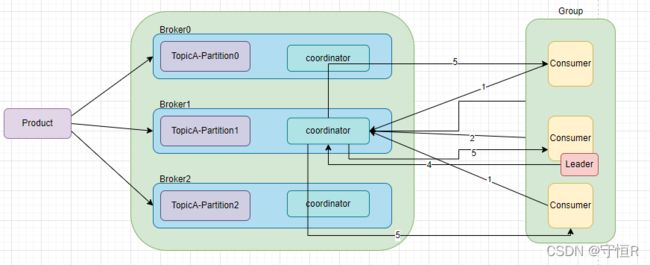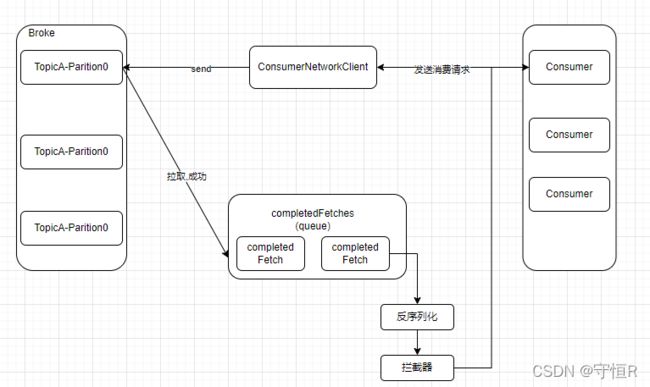Kafka消费者流程源码解析
1.说明
本文章简单流程追踪一下Kafka从服务端拉取数据到客户端的流程。
看完本文,你将会大致了解消费者数据消费的过程。
2.消费者示例
Properties properties = new Properties();
properties.put(ConsumerConfig.BOOTSTRAP_SERVERS_CONFIG, "xxx:9092");
properties.put(ConsumerConfig.KEY_DESERIALIZER_CLASS_CONFIG, StringDeserializer.class);
properties.put(ConsumerConfig.VALUE_DESERIALIZER_CLASS_CONFIG, StringDeserializer.class);
properties.put(ConsumerConfig.GROUP_ID_CONFIG, "test");
properties.put(ConsumerConfig.PARTITION_ASSIGNMENT_STRATEGY_CONFIG, "org.apache.kafka.clients.consumer.StickyAssignor");
KafkaConsumer<String, String> kafkaConsumer = new KafkaConsumer<>(properties);
// 订阅主题
kafkaConsumer.subscribe(Lists.newArrayList("test"));
while (true) {
// 拉取数据
ConsumerRecords<String, String> consumerRecords = kafkaConsumer.poll(Duration.ofSeconds(1));
for (ConsumerRecord<String, String> records : consumerRecords) {
System.out.println(records);
}
}
以上是一个简单的消费者demo,在开始源码之前务必 需要了解一下消费者消费初始化流程。
3.消费者消费初始化流程
 大致流程:
大致流程:
1.每个consumer都发送JoinGroup请求。
2.coordinator选出一个consumer作为leader。
3.把要消费的topic信息发送给leader消费者。
4.leader会制定一个消费方案,并把消费方案发给coordinator。
5.coordinator把消费方案下发给每个consumer。
6.每个consumer都会和coordinator保持心跳,默认3秒,一旦超时45秒,该消费者就会被移除,触发在平衡。
下面开始我们将重点分析数据拉取流程。
4.KafkaConsumer
KafkaConsumer的实例化:
private KafkaConsumer(ConsumerConfig config, Deserializer<K> keyDeserializer, Deserializer<V> valueDeserializer) {
try {
// 创建客户端对象
// reconnect.backoff.ms 连接重试时间 50ms
// reconnect.backoff.max.ms 最大连接重试时间 1s
// send.buffer.bytes 发送缓存 128kb
// receive.buffer.bytes 64kb
NetworkClient netClient = new NetworkClient(
new Selector(config.getLong(ConsumerConfig.CONNECTIONS_MAX_IDLE_MS_CONFIG), metrics, time, metricGrpPrefix, channelBuilder, logContext),
this.metadata,
config.getLong(ConsumerConfig.RECONNECT_BACKOFF_MS_CONFIG),
config.getLong(ConsumerConfig.RECONNECT_BACKOFF_MAX_MS_CONFIG),
config.getInt(ConsumerConfig.SEND_BUFFER_CONFIG),
heartbeatIntervalMs);
// 消费者分区分配策略
this.assignors = config.getConfiguredInstances(
ConsumerConfig.PARTITION_ASSIGNMENT_STRATEGY_CONFIG,
PartitionAssignor.class);
// 协助消费者初始化
// auto.commit.interval.ms 自动提交offset 5s
this.coordinator = groupId == null ? null :
new ConsumerCoordinator(logContext,
this.client,
groupId,
maxPollIntervalMs,
sessionTimeoutMs,
config.getBoolean(ConsumerConfig.LEAVE_GROUP_ON_CLOSE_CONFIG));
// 消费者抓取器
// fetch.min.bytes 最小一次抓取的字节数
// fetch.max.bytes 最大抓取的字节数
// fetch.max.wait.ms 抓取的等待时间
// max.poll.records 一次性返回的最大条数
this.fetcher = new Fetcher<>(
logContext,
this.client,
config.getInt(ConsumerConfig.FETCH_MIN_BYTES_CONFIG),
config.getInt(ConsumerConfig.FETCH_MAX_BYTES_CONFIG),
config.getInt(ConsumerConfig.FETCH_MAX_WAIT_MS_CONFIG),
config.getInt(ConsumerConfig.MAX_PARTITION_FETCH_BYTES_CONFIG),
apiVersions);
log.debug("Kafka consumer initialized");
}
}
实例化过程中初始化了几个比较重要的组件。
5.consumer.subscribe
public void subscribe(Collection<String> topics, ConsumerRebalanceListener listener) {
try {
log.info("Subscribed to topic(s): {}", Utils.join(topics, ", "));
// 订阅主题 (判断你是否需要更新订阅的主题) 注册了一个监听器,,有其他消费者挂了,需要重新分配
if (this.subscriptions.subscribe(new HashSet<>(topics), listener))
// 在平衡了,更新订阅信息
metadata.requestUpdateForNewTopics();
} finally {
release();
}
}
subscribe()方法:
public synchronized boolean subscribe(Set<String> topics, ConsumerRebalanceListener listener) {
// 注册负载均衡监听器
registerRebalanceListener(listener);
// 自动订阅模式
setSubscriptionType(SubscriptionType.AUTO_TOPICS);
// 是否需要更改订阅的主题
return changeSubscription(topics);
}
6.consumer.poll()
private ConsumerRecords<K, V> poll(final Timer timer, final boolean includeMetadataInTimeout) {
try {
do {
if (includeMetadataInTimeout) {
// 1.消费者 或者 消费者组的初始化
// try to update assignment metadata BUT do not need to block on the timer for join group
updateAssignmentMetadataIfNeeded(timer, false);
}
// 2.抓取数据
final Map<TopicPartition, List<ConsumerRecord<K, V>>> records = pollForFetches(timer);
if (!records.isEmpty()) {
// 3.拦截器处理数据
return this.interceptors.onConsume(new ConsumerRecords<>(records));
}
} while (timer.notExpired());
return ConsumerRecords.empty();
} finally {
}
}
拉取数据,然后在经过拦截器处理数据,最后返回。
pollForFetches(timer):
// 开始拉取数据
fetcher.sendFetches();
public synchronized int sendFetches() {
Map<Node, FetchSessionHandler.FetchRequestData> fetchRequestMap = prepareFetchRequests();
for (Map.Entry<Node, FetchSessionHandler.FetchRequestData> entry : fetchRequestMap.entrySet()) {
final Node fetchTarget = entry.getKey();
final FetchSessionHandler.FetchRequestData data = entry.getValue();
// maxWaitMs 最大等待时间,默认500ms
// minBytes 最少抓取一个字节
// maxBytes 最大抓取多少数据 默认50m
final FetchRequest.Builder request = FetchRequest.Builder
.forConsumer(this.maxWaitMs, this.minBytes, data.toSend())
.isolationLevel(isolationLevel)
.setMaxBytes(this.maxBytes)
.metadata(data.metadata())
.toForget(data.toForget())
.rackId(clientRackId);
// 发送拉取数据的请求
RequestFuture<ClientResponse> future = client.send(fetchTarget, request);
future.addListener(new RequestFutureListener<ClientResponse>() {
// 拉取成功的回调
@Override
public void onSuccess(ClientResponse resp) {
// 把数据添加到队列里面
completedFetches.add(new CompletedFetch(partition, partitionData,
metricAggregator, batches, fetchOffset, responseVersion));
}
});
}
}
发送拉取数据的请求,拉取到的数据放到队列里面。
